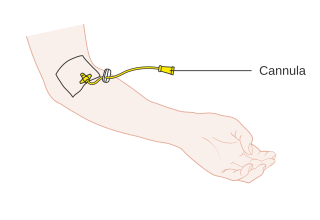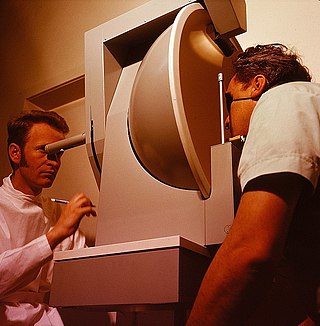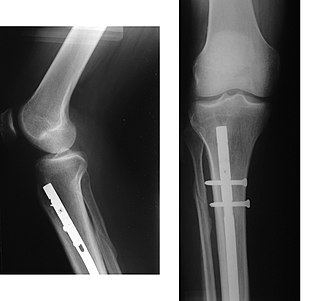Related Research Articles

A cannula is a tube that can be inserted into the body, often for the delivery or removal of fluid or for the gathering of samples. In simple terms, a cannula can surround the inner or outer surfaces of a trocar needle thus extending the effective needle length by at least half the length of the original needle. Its size mainly ranges from 14 to 26 gauge. Different-sized cannula have different colours as coded.

Glass brick, also known as glass block, is an architectural element made from glass. The appearance of glass blocks can vary in color, size, texture and form. Glass bricks provide visual obscuration while admitting light. The modern glass block was developed from pre-existing prism lighting principles in the early 1900s to provide natural light in manufacturing plants. Today glass blocks are used in walls, skylights, and sidewalk lights.

Glass microspheres are microscopic spheres of glass manufactured for a wide variety of uses in research, medicine, consumer goods and various industries. Glass microspheres are usually between 1 and 1000 micrometers in diameter, although the sizes can range from 100 nanometers to 5 millimeters in diameter. Hollow glass microspheres, sometimes termed microballoons or glass bubbles, have diameters ranging from 10 to 300 micrometers.
Eye tracking is the process of measuring either the point of gaze or the motion of an eye relative to the head. An eye tracker is a device for measuring eye positions and eye movement. Eye trackers are used in research on the visual system, in psychology, in psycholinguistics, marketing, as an input device for human-computer interaction, and in product design. In addition, eye trackers are increasingly being used for assistive and rehabilitative applications such as controlling wheelchairs, robotic arms, and prostheses. Recently, eye tracking has been examined as a tool for the early detection of autism spectrum disorder. There are several methods for measuring eye movement, with the most popular variant using video images to extract eye position. Other methods use search coils or are based on the electrooculogram.

A symphysis is a fibrocartilaginous fusion between two bones. It is a type of cartilaginous joint, specifically a secondary cartilaginous joint.
- A symphysis is an amphiarthrosis, a slightly movable joint.
- A growing together of parts or structures.

Kirschner wires or K-wires or pins are sterilized, sharpened, smooth stainless steel pins. Introduced in 1909 by Martin Kirschner, the wires are now widely used in orthopedics and other types of medical and veterinary surgery. They come in different sizes and are used to hold bone fragments together or to provide an anchor for skeletal traction. The pins are often driven into the bone through the skin using a power or hand drill. They also form part of the Ilizarov apparatus.

Ophthalmology was one of the foremost branches in medieval Islamic medicine. The oculist or kahhal (کحال), a somewhat despised professional in Galen's time, was an honored member of the medical profession by the Abbasid period, occupying a unique place in royal households. Medieval Islamic scientists considered it normal to combine theory and practice, including the crafting of precise instruments, and therefore found it natural to combine the study of the eye with the practical application of that knowledge. The specialized instruments used in their operations ran into scores. Innovations such as the "injection syringe", a hollow needle, invented by Ammar ibn Ali of Mosul, which was used for the extraction by suction of soft cataracts, were quite common.

In machining, boring is the process of enlarging a hole that has already been drilled by means of a single-point cutting tool, such as in boring a gun barrel or an engine cylinder. Boring is used to achieve greater accuracy of the diameter of a hole, and can be used to cut a tapered hole. Boring can be viewed as the internal-diameter counterpart to turning, which cuts external diameters.

A visual field test is an eye examination that can detect dysfunction in central and peripheral vision which may be caused by various medical conditions such as glaucoma, stroke, pituitary disease, brain tumours or other neurological deficits. Visual field testing can be performed clinically by keeping the subject's gaze fixed while presenting objects at various places within their visual field. Simple manual equipment can be used such as in the tangent screen test or the Amsler grid. When dedicated machinery is used it is called a perimeter.

A spray nozzle or atomizer is a device that facilitates the dispersion of a liquid by the formation of a spray. The production of a spray requires the fragmentation of liquid structures, such as liquid sheets or ligaments, into droplets, often by using kinetic energy to overcome the cost of creating additional surface area. A wide variety of spray nozzles exist, that make use of one or multiple liquid breakup mechanisms, which can be divided into three categories: liquid sheet breakup, jets and capillary waves. Spray nozzles are of great importance for many applications, where the spray nozzle is designed to have the right spray characteristics.
A latex fixation test, also called a latex agglutination assay or test, is an assay used clinically in the identification and typing of many important microorganisms. These tests use the patient's antigen-antibody immune response. This response occurs when the body detects a pathogen and forms an antibody specific to an identified antigen present on the surface of the pathogen.
Vertebral fixation is an orthopedic surgical procedure in which two or more vertebrae are anchored to each other through a synthetic "vertebral fixation device", with the aim of reducing vertebral mobility and thus avoiding possible damage to the spinal cord and/or spinal roots.

An intramedullary rod, also known as an intramedullary nail or inter-locking nail or Küntscher nail, is a metal rod forced into the medullary cavity of a bone. IM nails have long been used to treat fractures of long bones of the body. Gerhard Küntscher is credited with the first use of this device in 1939, during World War II, for soldiers with fractures of the femur. Prior to that, treatment of such fractures was limited to traction or plaster, both of which required long periods of inactivity. IM nails resulted in earlier return to activity for the soldiers, sometimes even within a span of a few weeks, since they share the load with the bone, rather than entirely supporting the bone.
Cannula, used alone or in combination with other words, has several meanings. It derives from the Latin "little reed"; and often refers to a tube.

A pig bladder or pig's bladder is the urinary bladder of a domestic pig, similar to the human urinary bladder. Today, this hollow organ has various applications in medicine, and in traditional cuisines and customs. Historically, the pig bladder had several additional uses, all based on its properties as a lightweight, stretchable container that could be filled and tied off.

The Herbert screw is a variable pitch cannulated screw typically made from titanium for its biocompatible properties as the screw is normally intended to remain in the patient indefinitely. It became generally available in 1978. It is one of the earliest designs of headless compression screws which are used to achieve interfragmentary compression through its differential pitch between the threads at each end of the screw.
Retinal birefringence scanning (RBS) is a method for detecting the central fixation of the eye. The method can be used in pediatric ophthalmology for screening purposes. By simultaneously measuring the central fixation of both eyes, small- and large-angle strabismus can be detected. The method is not invasive and requires little cooperation by the patient, so it can be used for detecting strabismus in young children. The method provides a reliable detection of strabismus and has also been used for detecting certain kinds of amblyopia. RBS uses the human eye's birefringent properties to identify the position of the fovea and the direction of gaze, and thereby to measure any binocular misalignment.

An orthopedic plate is a form of internal fixation used in orthopaedic surgery to hold fractures in place to allow bone healing and to reduce the possibility of nonunion. Most modern plates include bone screws to help the orthopedic plate stay in place.
A slicer is a toolpath generation software used in 3D printing. It facilitates the conversion of a 3D object model to specific instructions for the printer. The slicer converts a model in STL (stereolithography) format into printer commands in G-code format. This is particularly usable in fused filament fabrication and other related 3D printing processes.
References
- ↑ Ory, François & Fraysse, Jean-Luc & Veisse, Philippe. (2020). Cannulated bar technology for the orthopaedics: application and processing. MATEC Web of Conferences.